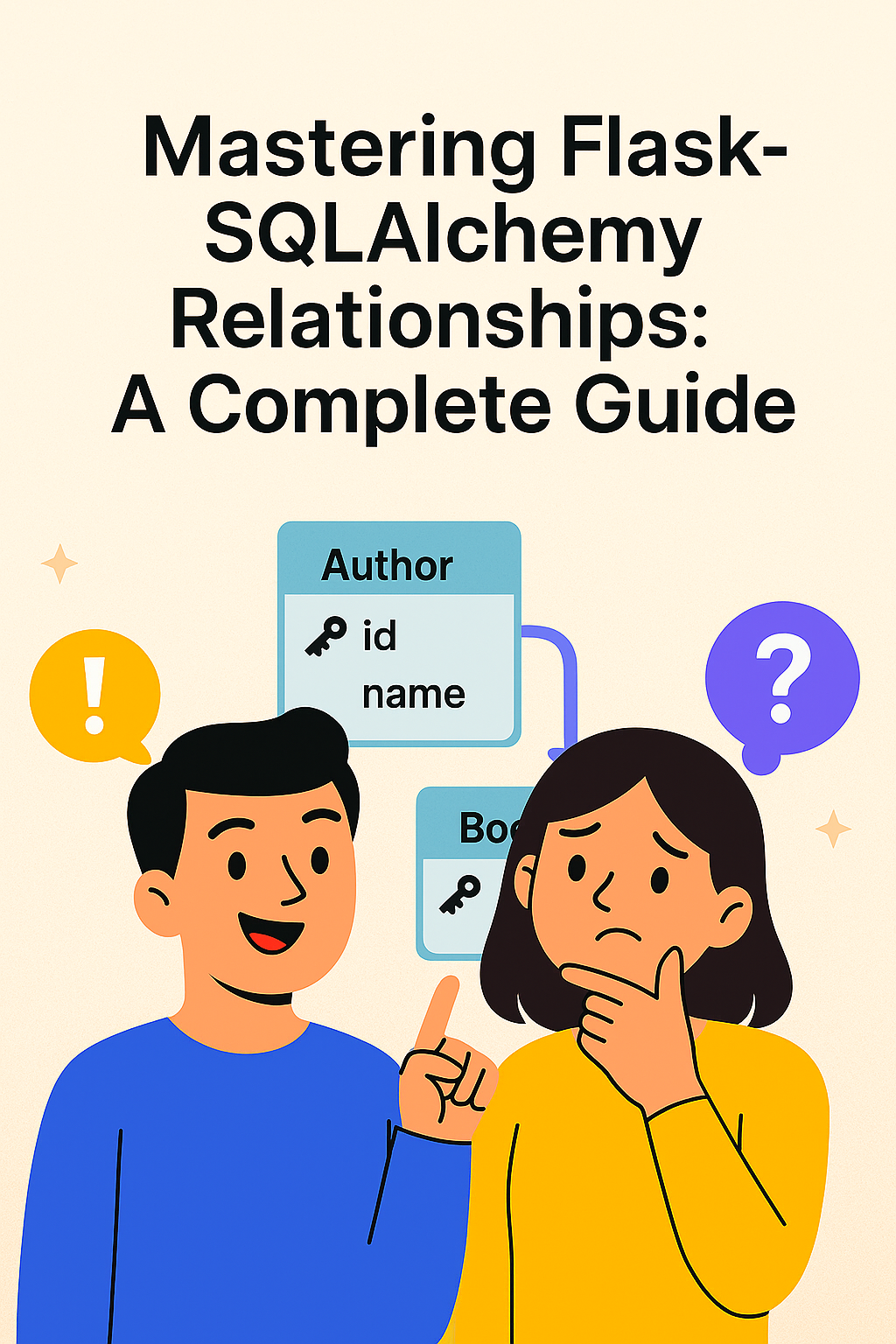If you’re building a web application using Flask and need to manage related data models (like users and their posts or authors and books), then understanding how to use Flask-SQLAlchemy relationships is critical. This blog post is your comprehensive guide to defining, using, and troubleshooting relationships in Flask-SQLAlchemy.
New to Flask? First, read What is Flask? for a beginner-friendly introduction.
What is Flask-SQLAlchemy?
Flask-SQLAlchemy is a Flask extension that integrates SQLAlchemy with your Flask application. SQLAlchemy is a powerful ORM (Object-Relational Mapper) that lets you work with your database using Python classes and methods instead of raw SQL.
Just getting started? Check out the Flask-SQLAlchemy Quickstart for setup and first steps.
What is a Flask-SQLAlchemy Relationship?
A Flask-SQLAlchemy relationship connects two or more database tables through Python class relationships. These relationships model how rows in one table are linked to rows in another—such as a one-to-many or many-to-many association.
Types of Flask-SQLAlchemy Relationships
Flask-SQLAlchemy supports several types of relationships:
- One-to-Many
- Many-to-One
- Many-to-Many
- One-to-One
Let’s break each of these down.
One-to-Many Relationship in Flask-SQLAlchemy
This is the most common relationship. For example, one Author can write many Books.
from flask_sqlalchemy import SQLAlchemy
db = SQLAlchemy()
class Author(db.Model):
id = db.Column(db.Integer, primary_key=True)
name = db.Column(db.String(80))
books = db.relationship('Book', backref='author', lazy=True)
class Book(db.Model):
id = db.Column(db.Integer, primary_key=True)
title = db.Column(db.String(120))
author_id = db.Column(db.Integer, db.ForeignKey('author.id'), nullable=False)Key Points:
db.relationshipis declared on the “one” side (Author)db.ForeignKeyis declared on the “many” side (Book)backref='author'adds a shortcut fromBooktoAuthor
Many-to-Many Relationship in Flask-SQLAlchemy
Many students can enroll in many courses. This requires an association table.
enrollments = db.Table('enrollments',
db.Column('student_id', db.Integer, db.ForeignKey('student.id'), primary_key=True),
db.Column('course_id', db.Integer, db.ForeignKey('course.id'), primary_key=True)
)
class Student(db.Model):
id = db.Column(db.Integer, primary_key=True)
name = db.Column(db.String(80))
courses = db.relationship('Course', secondary=enrollments, backref='students')
class Course(db.Model):
id = db.Column(db.Integer, primary_key=True)
title = db.Column(db.String(120))
Key Points:
secondarydefines the association table- Both classes use
db.relationshipto access the related objects
One-to-One Relationship in Flask-SQLAlchemy
This is a special case of one-to-many with uselist=False.
class User(db.Model):
id = db.Column(db.Integer, primary_key=True)
profile = db.relationship('Profile', backref='user', uselist=False)
class Profile(db.Model):
id = db.Column(db.Integer, primary_key=True)
bio = db.Column(db.String(255))
user_id = db.Column(db.Integer, db.ForeignKey('user.id'))
Key Point:
- Set
uselist=Falseto signal a one-to-one relationship
Best Practices for Flask-SQLAlchemy Relationships
- Use
lazy='select','joined', or'dynamic'depending on use case - Avoid circular imports by defining models in a single file or using application factories properly
- Use
back_populatesfor explicit two-way bindings instead ofbackrefif you want more control
class Parent(db.Model):
id = db.Column(db.Integer, primary_key=True)
children = db.relationship("Child", back_populates="parent")
class Child(db.Model):
id = db.Column(db.Integer, primary_key=True)
parent_id = db.Column(db.Integer, db.ForeignKey("parent.id"))
parent = db.relationship("Parent", back_populates="children")
Confused between SQLAlchemy and Flask-SQLAlchemy? Read this comparison: SQLAlchemy vs Flask-SQLAlchemy – Which to Choose?
Troubleshooting Flask-SQLAlchemy Relationships
Here are common issues you might face:
❌ sqlalchemy.exc.NoForeignKeysError
You forgot to define a
ForeignKey.
❌ DetachedInstanceError
You’re trying to access a related object outside of a session. Use
db.session.add()properly.
❌ sqlalchemy.exc.InvalidRequestError
There’s likely a circular reference or a misconfigured relationship.
Debug Tip:
Set app.config['SQLALCHEMY_ECHO'] = True to log SQL statements in the console for easier debugging.
Querying Flask-SQLAlchemy Relationships
Here’s how you work with relationships in real use:
author = Author.query.first()
print(author.books) # list of books
book = Book.query.first()
print(book.author.name) # name of the author
You can also filter related models:
Author.query.filter(Author.books.any(title='Flask 101')).all()
Testing Flask-SQLAlchemy Relationships
Use Flask’s shell to test:
flask shell
Inside the shell:
from your_app import db, Author, Book
author = Author(name='Jane Doe')
book1 = Book(title='Flask 101', author=author)
db.session.add_all([author, book1])
db.session.commit()
Conclusion: Why Flask-SQLAlchemy Relationships Matter
Whether you’re building a blog, e-commerce store, or a learning platform, properly defining and managing Flask-SQLAlchemy relationships ensures your data models are accurate, efficient, and scalable.
By mastering relationships, you can build more complex apps with confidence and clean, maintainable code.


Comments